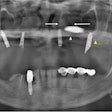
Looking at the schedule with my team in the morning, I am always intrigued by the code D0140 - Limited oral evaluation -- problem-focused. When I see that code for an appointment, 100% of my focus is on the patient and solving the underlying issue causing the patient's dental distress. It means something is happening with this patient, and I need to help.
The first step to solving the mystery of the patient's pain is to look at the appointment note. For instance, it may say "Pain in the LR quadrant."
But when I want to locate and solve the "pain points" in my practice, I can't turn to a code and appointment note in the same way that I can for a patient.
 Dr. James V. Anderson
Dr. James V. AndersonI can look at reports in the practice management software, but numbers can only tell me so much. What caused production to be high on this day but dismal the next day? Or suppose that the numbers are good, but there are critical issues with the team getting along. What was going on with the team each day?
There is an old saying, "Little things mean a lot," which can be applied to any day in a busy dental practice. Have we looked at each day with the same focus we look at x-rays for signs of disease?
One way to open the door to solving more significant issues is to ask the team in a safe team meeting what "little things" bug them. Often a team member does not want to appear nitpicky and won't say anything about an annoying or ineffective system. You may want to meet separately with each department or employee to get each person's perspective.
Below is a list of issues that may be considered minor at first glance but can cause significant pain for your dental practice:
- Problem: The computers are too slow to load pages. Resolution: Maintain, improve, or upgrade the computer hardware.
- Problem: There is high staff turnover, and there is no time to train more people. Resolution: What is causing the turnover? Discuss the time involved to train new employees and determine who will be in charge of training.
- Problem: The practice is running out of certain supplies. Resolution: Assign a person to find out the cause of the shortage and identify resources for supplies or alternatives.
- Problem: You and your staff are worried about exposure to COVID-19 and its variants. Resolution: Check all personal protective equipment (PPE) for safety against SARS-CoV-2 transmission as well as for guidance updates on PPE. Educate yourself and your staff about COVID-19 and its variants. Schedule patients to allow for better distancing.
- Problem: Instruments are not getting processed. Resolution: Why is processing not happening? If it's a staff shortage, hire. If it's an instrument shortage, schedule in processing time.
- Problem: The kitchen area is dirty and/or has dirty dishes. Resolution: Everyone is responsible for their dishes. If dishes are not cleaned up, they go in the trash at the end of the day.
- Problem: The coffee runs out, and no one makes a new pot. Resolution: Assign one person to make coffee daily and brew a new batch when it runs out. Or you can change to a pod system, where each person can brew a cup.
- Problem: Delays in processing claims are angering patients. Resolution: Assign a front desk team member to look into why the claims are slow to process and what can be done to speed things up, or outsource your billing to an insurance billing company.
- Problem: Your staff has trouble following up on claims that have not been paid, or there are rejected claims or rejections that are causing slower turnaround payments. Resolution: Assign the front desk time to follow up on claims that is separate from patient interaction, or outsource claims processing to an insurance billing company.
- Problem: Patients with insurance are not eligible for treatment. Resolution: Verify insurance coverage and benefits before the patient comes in for treatment, or outsource to an insurance billing company that will do this for you.
Let's look at our practice issues like our patients' dental problems. We can diagnose and treat when we focus on the symptoms that are creating the disease.
The monthly team meeting should be more than a recital of practice numbers and goals. While numbers are significant, in today's world, we should look at our websites to improve our content, our online reputation and social media connections, and keep up with trends and marketing ideas.
It's also important to look at our systems and practice policies and update them regularly. There are often little issues within these areas that can grow into big problems.
To help ensure that everyone is on the same page, consider projecting the schedule onto a screen during your daily organizational meeting or "morning huddle." This step helps you analyze each patient and where the team needs to be at any given time. It also allows you to ditch the distracting paper so that people are focused on the same information and can view each appointment as a team.
Dr. James V. Anderson is a practicing dentist in Syracuse, UT, and is the CEO and founder of eAssist Dental Solutions. He can be reached via email.
The comments and observations expressed herein do not necessarily reflect the opinions of DrBicuspid.com, nor should they be construed as an endorsement or admonishment of any particular idea, vendor, or organization.


















